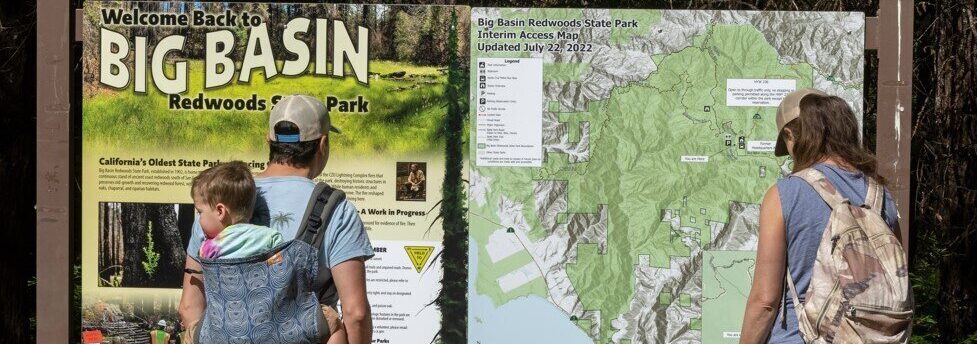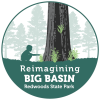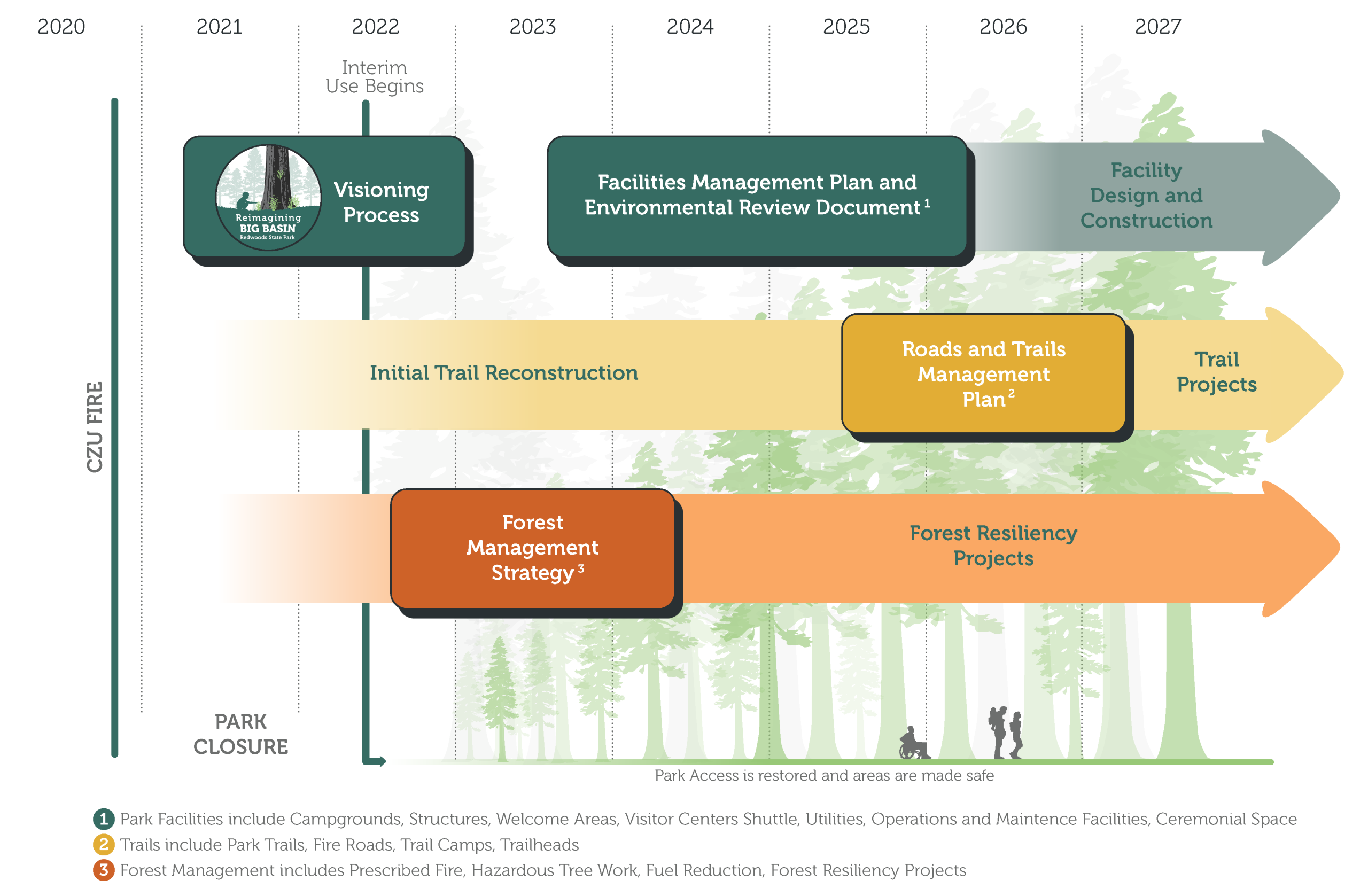Post-Fire Park Access
Day Use Parking Reservation System
Big Basin is now open for limited day-use access. Reservations for parking are highly recommended to ensure access. The parking fee is $6 per vehicle plus a $2 reservation fee. No reservations are needed for visitors arriving by foot, bike, or bus. Read the FAQs for more information on the reservation system, bus and shuttle programs, and visiting Big Basin.

All trails, campgrounds and day-use areas were damaged or lost in the CZU Fire in 2020. State Parks has been working with support from partners to rebuild trails and provide safe public access to areas of the park. Access to additional trails and back country roads will be made available as they are cleared and made safe.
Visit the official State Parks website for the most up-to-date information about visiting Big Basin Redwoods State Park.
Visit Big Basin by Public Transit
Santa Cruz Metro is now offering weekend service during summer months to Big Basin Redwoods State Park on Bus Route 35. No entrance fee or reservation is required for visitors who arrive by bus. Save money and reduce greenhouse gas emissions, take the bus!
Ongoing Recovery Efforts
California State Parks is working to plan for long-term forest recovery and permanent reestablishment of public access to much of the park. This requires a multi-year planning and environmental review process that includes several important documents. The diagram below outlines key planning milestones, including the Reimagining Big Basin Vision Summary, Facilities Management Plan, Forest Management Strategy, and Roads and Trails Management Plan, among others.
Simultaneously, California State Parks is reopening more trails and facilities to support safe and improved public access to the park in the near-term while long-range planning efforts are underway.
Trails
Pre-fire trails and fire roads will be rebuilt and made available for public access as they are made safe and accessible. It is expected to take many years to reconstruct the entire road and trail network. Opportunities to consider additional trails, trail uses, trailheads and trail camps that could add to the pre-fire trail network may be considered through the process of developing a future Roads and Trails Management Plan. For information on trails and fire roads that are currently open and accessible, visit the main Big Basin webpage.
Frequently Asked Questions
Partial day-use access to the main day-use area opened by reservation only on July 22, 2022. Highway 236 opened to through traffic at the same time. This interim day-use access will expand in future years as more trails and areas of the park made safe and accessible while the permanent park facilities are planned and built.
Other areas of the park and most park trails will remain closed until they can be made safe for public access. Reestablishing full access to the park is expected to take many years.
State Parks continues to assess trail networks, trail signs, opportunities for camping, and safety protocols as it coordinates a responsible use plan for the public. Trail crews continue to work on the trail system and trail segments will open as they are reconstructed and made safe.
There is also currently limited access without needing a reservation at Rancho Del Oso entrance, as well as camping opportunities there.
For more information on what is open, see the main Big Basin webpage or the interim park map.
Highway 236 is open to through traffic including vehicles and bicycles. Also, Skyline to the Sea Trail between Castle Rock State Park and Big Basin Redwood State Park Main Day-use Area is open for hiking. Parking in the main day-use area is guaranteed only by prior online reservation.
For more information and to book a reservation, see the main Big Basin Redwoods State Park webpage.
More than 97% of Big Basin (17,792 of 18,224 acres) was within the fire perimeter of the CZU Lightning Complex Fire. The fire burned with different intensity in different portions of the park, affecting ecosystems and habitats differently. State Park Environmental Scientists and research partners continue to consider the impact of the fire on different ecosystems. Nearly all of the buildings and infrastructure were damaged. This includes about 100 structures, all of the campgrounds, and all trail networks. State Parks and partners have completed extensive field work and development of a Forest Management Strategy for the forested areas of Big Basin, Butano and Año Nuevo State Parks, which outlines forest treatments to increase forest resiliency.
Redwood trees are remarkably resilient, and the majority of scorched redwood trees in Big Basin have begun to re-sprout from buds at their bases and along their branches. Hardwood trees, including madrone, live oak, and tan oak are sprouting from their bases. Many of the ferns, shrubs and understory plants have started to re-grow.
Researchers will be assessing the impacts to species that depend on the old growth redwood forest. Most animals in the forest have ways to escape fire. Many flee the area or seek refuge in safe spots. Some species take advantage of the fire — such as woodpeckers returning to dead trees and deer browsing on new shoots. Other species will shift to unburned areas until their habitat re-grows.
The Santa Cruz Mountains Bioregional Council provides additional information about CZU Fire impacts on wildlife and post-fire habitat recovery.
The severity of a fire is influenced by many things, including topography, weather and vegetation. The CZU Lightning Complex Fire occurred during a week of record high temperatures and low humidity that dried the vegetation. Thousands of dry lightning strikes ignited hundreds of fires across California at the same time. In the Santa Cruz Mountains, several lightning fires combined to create the larger fire that swept into Big Basin.
The first phase of planning has been to develop a vision document for the park with broad aspirations for what the reimagined park will look like. The Reimagining Big Basin Vision Summary is now complete. This public planning process involved partners, stakeholders, local communities, and the public. With completion of the vision document, there will be several subsequent phases of park planning for the park, including the development of the currently-underway parks Facilities Management Plan, and subsequent design and construction of park facilities and implementation of resource stewardship projects. The planning and reestablishment of the park infrastructure will take several years and continues to include public involvement.
Planning and reconstructing will require reimagining the park for climate resiliency and equitable public access for decades to come. The reconstructed park will not look exactly as it was. The location and design of facilities, transportation and visitor infrastructure will need to address changing climatic conditions, as well as an evolving understanding of forest health and needs. Big Basin holds a special place in the heart of millions of visitors. It is with this great responsibility that the planning and design of facilities will incorporate transparency and public input to best serve the park in the future while retaining the heritage and memories of the past.
There is limited access to the park and it will be expanded in future years as additional trails are reconstructed and additional areas are made safe. Access will increase as much as is possible prior to completing construction of the permanent park facilities. State Parks continues to assess trail networks, trail signs, opportunities for camping, and safety protocols as it coordinates a responsible use plan for the public. Trail crews continue to work on the trail system and trail segments will open as they are reconstructed and made safe.
For more information on what is open, see the main Big Basin Redwoods State Park webpage.
Thank you for loving Big Basin Redwoods State Park. The planning process for the park will rely on input from stakeholders and the public. Please follow along for opportunities to help plan for the future of this treasured park.
- To make a donation, visit our partners’ webpages listed here.
- To offer volunteer support, fill out a volunteer application form.


